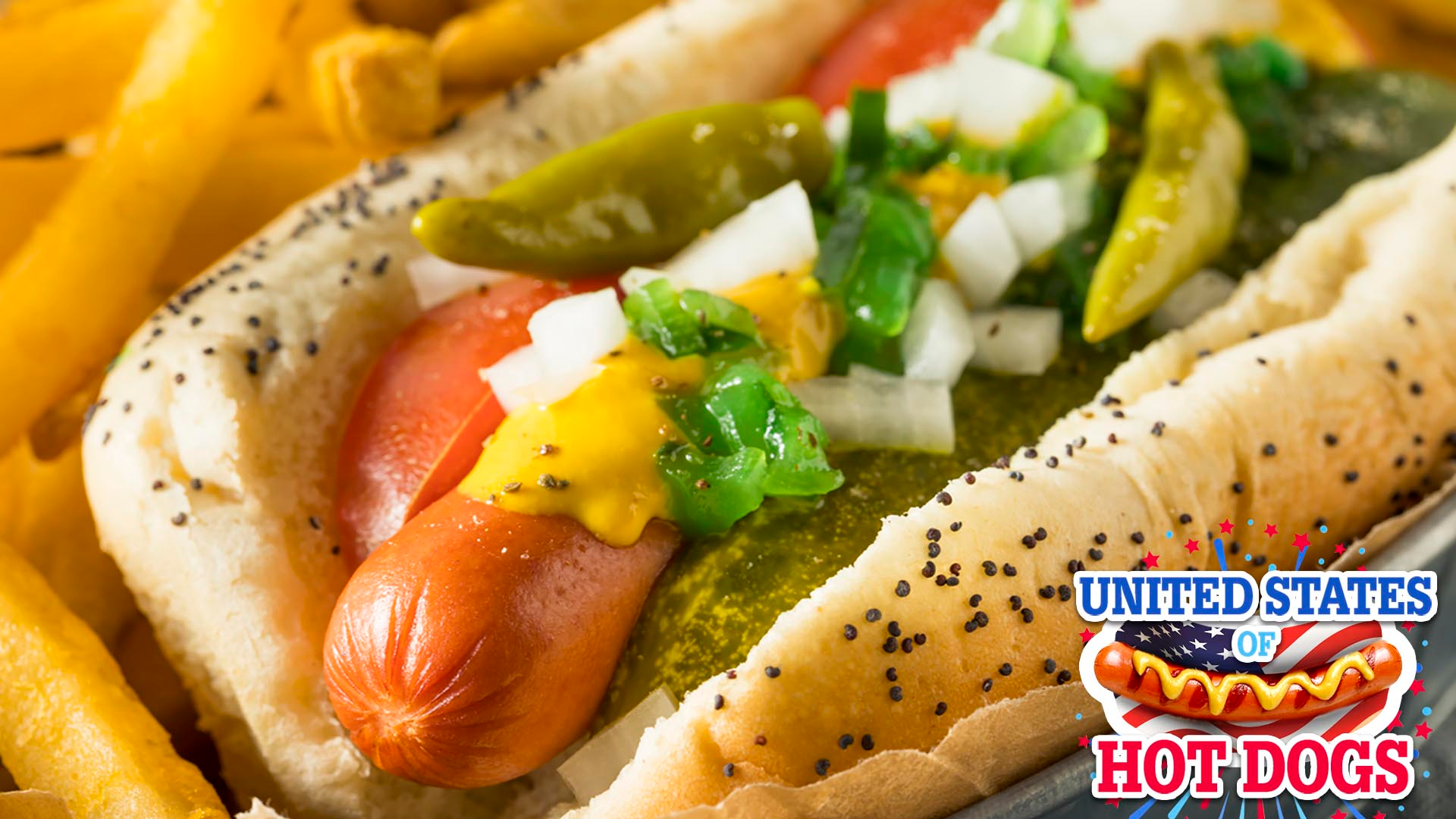Chicago's Hot Dogs Are Variations On A Theme
United States of Hot Dogs is a recurring feature exploring the historic origins and modern appeal of America's regional hot dogs.
The thing about growing up in a town with a definite hot dog culture—in my case, Chicago—is that you don't even realize there's anything special about your local hot dog. As a kid, I would go to hot dog stands and see framed posters of giant hot dogs in place of Chicago landmarks, and it didn't register to me that this was because this particular hot dog—the Vienna—was meant to be an integral part of the city. Because for me, the only distinct hot dog categories were the bland, bunless Oscar Mayers I got at home and the juicier, better-tasting hot dogs I ate when we went out.
As I grew older, the propaganda did its work, and I learned better. A Chicago hot dog is an all-beef Vienna frank in a poppy-seed bun dressed with mustard, relish, chopped raw onion, sliced tomato, a kosher pickle spear, sport peppers, and celery salt. The toppings always go on in this order. No decent Chicagoan would ever dream of adding ketchup. That would be a blasphemy. (One classic hot dog stand, Gene and Jude's, has banned ketchup altogether, even for French fries. Customers have resorted to smuggling in their own.) All this was codified by the Vienna Beef Company in the '70s and disseminated at hot dog stands throughout the city and suburbs and also at Vienna's Hot Dog University. But here's the other thing about Chicago hot dogs: Despite what Vienna wants you to believe, not all hot dogs here follow the Vienna party line, not by a long shot.
Here at The Takeout we talk about Midwestern food a lot. I don't think there's any food that is particularly Midwestern the way black-eyed peas are Southern or clam chowder is New England or chili is Texas: a blending of local ingredients with the culinary traditions of Native Americans, Europeans, and Africans. The naturally-growing foods of the Midwest, the corn, beans, and squash eaten by Native Americans, never really integrated with the food brought by settlers from other places, particularly since these settlers also came here equipped with canned food. There was never a need to adapt old traditions to fit with new ingredients. If you wanted to eat oyster stew in Chicago you could, even though it was 2,000 miles from the ocean.
The only food in Chicago—and the Midwest in general—that approaches the blend of food traditions of other parts of the country is the hot dog. As the food historian Bruce Kraig writes in his excellent book Hot Dog: A Global History, "If Jews made hot dogs, Greeks, Macedonians, Bulgarians, Italians, and Mexicans dressed them." Vienna was founded by two Jewish immigrants, Emil Reichl and Samuel Ladanyi. Their hot dogs were all-beef to appeal to kosher, or kosher-ish, customers—plus, some people considered beef higher-quality than the pork in other hot dogs. Greek and Italian vegetable vendors added the tomatoes, pickles, and peppers during the Great Depression. There are Vienna stands all over this very segregated city, in mostly-white areas and mostly-Black areas, in poor city neighborhoods and in wealthy suburbs. But not all hot dogs are the same.
Gene and Jude's, for instance, serves what it calls a Depression dog, which leaves off the pickle, tomato, and celery salt, and dumps a pile of fries on top. Superdawg, a drive-in on the city's northwest side, uses its own proprietary sausages, which are larger than the Vienna's, leaves off the celery salt, and pickles the tomato. (Superdawg is also notable for its rooftop mascots Maurie and Flaurie, a pair of anthropomorphic and flirtatious hot dogs named after the original owners.)
Unlike New York, which has a vibrant pushcart culture, Chicago initially discouraged vendors from selling hot dogs outside on sidewalks. Kraig writes that civic leaders were concerned about horse dung contaminating food. So the Chicago hot dog has been traditionally consumed at hot dog stands, tiny places where customers had to... well, stand, though many have since added seating (generally molded plastic booths). And hot dog stands don't just sell hot dogs: They represent the idea that the Chicago hot dog is a theme with variations.
Thus the Polish sausage, not technically a hot dog, but almost always available at hot dog stands, served with grilled onions and mustard. The sausage is a kielbasa, which technically makes it Polish, but the sandwich itself was invented by a Macedonian immigrant, Jim Stefanovic, at his hot dog stand Jim's Original.
And also the mother-in-law: all the Chicago-style fixings on a Chicago-style tamale. It got its name, claims one vendor, because, like a mother-in-law, it gives you heartburn. It was invented by John Pawlikowski, proprietor of Fat Johnnie's in the Chicago Lawn neighborhood on the South Side, a Polish-American who was, in turn, inspired by a Lithuanian-American guy from his childhood neighborhood named Pete who sold tamales in a bun with ketchup. The tamales are Chicago-style because they aren't made with masa like Mexican tamales, but with cornmeal in the style of tamales brought north by Blacks from the Mississippi Delta during the Great Migration. But the biggest manufacturer of Chicago-style tamales is Tom Tom Tamales, run by a Greek family. And there you have it: Midwestern foodways embodied by a cylindrical object in a bun.
But what about the ketchup thing, which shows a definite lack of acceptance and adaptability? Contrary to popular belief, it is not illegal to eat a hot dog with ketchup in the city of Chicago. It's just not a Chicago-style hot dog. Chicagoans are proud of being Chicagoans. It's born out of a deep insecurity about being compared to New York and L.A. and found wanting—too small, too cold. For God's sake, let us just have this one thing.
